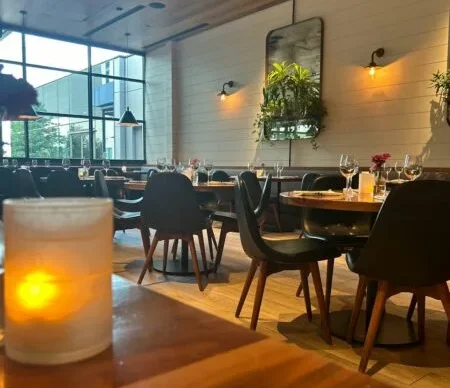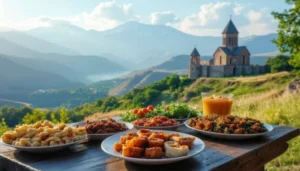Imagine stepping into a cozy corner where the air is thick with the aroma of freshly baked lavash bread and simmering stews, where conversations flow as freely as the strong Armenian coffee. Authentic Armenian cafe restaurants offer more than just a meal—they provide a portal to a rich cultural tapestry woven from centuries of history, resilience, and flavorful innovation. In this exploration, we’ll delve into the heart of these hidden gems, uncovering the traditions that define them and the bold flavors that captivate the palate. Whether you’re a food enthusiast seeking new tastes or a traveler eager for cultural immersion, discovering an Armenian cafe restaurant promises an unforgettable experience that lingers long after the last bite.
The Rich Heritage Behind Armenian Cafe Restaurants
Armenian cuisine is a testament to the nation’s enduring spirit, shaped by its position at the crossroads of Europe and Asia. For centuries, Armenia has absorbed influences from Persian, Ottoman, Russian, and Middle Eastern neighbors, blending them into a unique culinary identity. At the core of this heritage are Armenian cafe restaurants, which evolved from traditional khan (inns) and teahouses into vibrant social hubs. These establishments weren’t just places to eat; they were communal spaces where stories were shared, deals were struck, and families bonded over plates of dolma and glasses of cognac.
Historically, the Armenian cafe restaurant scene traces back to the 19th century in cities like Yerevan and Constantinople (now Istanbul), where diaspora communities established eateries to preserve their customs amid migration and upheaval. The 1915 Armenian Genocide scattered these traditions further, leading to thriving Armenian cafe restaurants in places like Los Angeles, Paris, and Beirut. Today, these spots honor that legacy by sticking to time-tested recipes passed down through generations, often using ingredients sourced from Armenia’s fertile Ararat Valley.
What sets an authentic Armenian cafe restaurant apart is its commitment to simplicity and seasonality. Unlike flashy fusion spots, these cafes prioritize fresh, local produce—think juicy apricots, robust walnuts, and earthy herbs. This heritage isn’t static; it’s alive in every dish, reminding patrons of Armenia’s mountainous landscapes and ancient monasteries. As you explore, you’ll notice how these restaurants serve as cultural ambassadors, bridging the old world with the new.
Evolution of Cafe Culture in Armenia
The evolution of Armenian cafe restaurants mirrors the country’s own journey. In rural Armenia, cafes often double as village gathering points, similar to European bistros but infused with Eastern warmth. Urban centers like Yerevan boast elegant establishments with Art Nouveau facades, a nod to the Belle Époque era when Armenian intellectuals frequented them for lively debates. Post-Soviet independence in 1991 revitalized this scene, with a surge in family-run Armenian cafe restaurants emphasizing organic, farm-to-table practices.
Globally, the Armenian diaspora has globalized these flavors. In Glendale, California—home to one of the largest Armenian communities—an Armenian cafe restaurant might feature live duduk music alongside its menu, evoking the soulful melodies of ancient Armenia. This evolution ensures that traditions remain dynamic, adapting to modern tastes while staying true to their roots.
Signature Flavors of Authentic Armenian Cafe Restaurants
Diving into the menu of an Armenian cafe restaurant is like embarking on a flavor odyssey. The cuisine balances bold spices with subtle sweetness, hearty proteins with vibrant vegetables. Central to every meal is the use of fresh herbs like dill, parsley, and mint, which add a refreshing zing. Staples such as yogurt and cheese provide creamy textures, while fruits like pomegranate and quince lend a tangy sweetness unique to the region.
One cannot discuss Armenian cafe restaurants without highlighting lavash, the thin, unleavened flatbread that’s UNESCO-recognized as intangible cultural heritage. Baked in traditional tonir ovens, it’s the perfect vessel for scooping up dips or wrapping meats. In an authentic setting, lavash arrives warm and pliable, its smoky essence elevating even the simplest dishes.
Iconic Appetizers and Mezes
Begin your meal with mezes, the small plates that set the tone in any Armenian cafe restaurant. Basturma, air-dried beef coated in a spicy fenugreek paste, offers a chewy, garlicky punch that’s addictive. Pair it with matzoon (yogurt) for a cooling contrast. Another must-try is jingyalov hats, a herb-stuffed flatbread from the Artsakh region, packed with wild greens like spinach, sorrel, and nettle—ideal for vegetarians seeking bold, earthy notes.
Don’t miss ghapama, a stuffed pumpkin that’s more than an appetizer; it’s a celebration. Hollowed out and filled with rice, dried fruits, and nuts, then baked until caramelized, it embodies Armenia’s harvest traditions. In an Armenian cafe restaurant, servers might present it tableside, sliced to reveal its colorful interior, encouraging communal sharing.
- Tip for Ordering: Start with a meze platter to sample varieties—it’s a cost-effective way to explore flavors without overcommitting.
- Actionable Advice: Ask for seasonal specials; authentic spots rotate ingredients based on availability, ensuring peak freshness.
Main Courses: Hearty and Soul-Warming
The mains in an Armenian cafe restaurant are where comfort meets complexity. Khorovats, Armenia’s answer to barbecue, features marinated meats—lamb, pork, or chicken—grilled over open flames. Seasoned with salt, pepper, and sometimes sumac, they’re served with charred vegetables and luleh kebabs (ground meat skewers). The char adds a smoky depth that pairs beautifully with tangy tkemali sauce made from unripe plums.
For a vegetarian twist, opt for zhingyalov hats variants or kufta, semolina dumplings stuffed with spiced meat or lentils. Stews like spas (yogurt soup with barley and greens) warm the soul on cooler days, reflecting Armenia’s pastoral roots. In diaspora-run Armenian cafe restaurants, you might find innovative takes, like khorovats tacos, blending tradition with local flair.
Seafood shines in coastal-influenced spots, with grilled trout from Lake Sevan seasoned with lemon and dill. These dishes highlight Armenia’s emphasis on whole, unprocessed foods—meats are often grass-fed, and grains stone-ground for authenticity.
- Pairing Suggestion: Balance rich mains with a side of pickled vegetables (torshi) to cut through the fats.
- Practical Tip: Request medium-rare for khorovats to retain juiciness; overcooking dries out the meat.
Sweet Endings: Desserts That Delight
No visit to an Armenian cafe restaurant is complete without indulging in sweets. Gata, a sweet bread filled with butter, sugar, and nuts, comes in regional varieties—like the walnut-stuffed gata from Van. It’s often enjoyed with tea, its crumbly texture evoking childhood memories for many Armenians.
Pakhlava, Armenia’s take on baklava, layers phyllo with honey, walnuts, and cinnamon, but uses less syrup for a lighter finish. For something fruity, try sutlakh, a rice pudding infused with rosewater and topped with pistachios. These desserts aren’t overly cloying; they celebrate Armenia’s orchard bounty, with apricots and figs making frequent appearances.
In modern Armenian cafe restaurants, you’ll find creative fusions like gata ice cream or pakhlava parfaits, appealing to younger crowds while honoring classics.
- Actionable Advice: Share desserts family-style to savor more options without excess.
- Insider Tip: Look for house-made halvah; it’s fresher and less processed than store-bought.
Beverages: The Liquid Soul of Armenian Cafe Restaurants
Beverages in an Armenian cafe restaurant are as integral as the food, often dictating the meal’s rhythm. Coffee reigns supreme, with surj (Armenian coffee) brewed in a jezve over hot sands for a robust, aromatic brew. Served in small demitasse cups with a side of lokum (Turkish delight), it’s perfect for lingering chats.
Tea, or tzhvar, is another staple, herbal blends like mint or chamomile sipped throughout the day. For something stronger, Armenian cognac—brands like Ararat—offers smooth, fruity notes from oak-aged brandy. Non-alcoholic options include tan, a yogurt-based drink that’s refreshing and probiotic-rich.
Wine and Traditional Drinks
Armenia claims to be the world’s oldest wine-producing region, dating back 6,000 years. In an Armenian cafe restaurant, pair your meal with indigenous varietals like Areni red—bold and berry-forward—or Voskehat white, crisp with citrus undertones. Many spots feature wine lists highlighting small-batch producers from the Vayots Dzor region.
Traditional drinks like verj (pomegranate wine) add a tart twist, while arak (anise-flavored spirit) is for post-meal toasts. For families, fruit compotes (tarkhun with tarragon) provide sweet, hydrating alternatives.
- Pairing Tip: Match Areni with khorovats for its tannins to complement grilled meats.
- Practical Advice: Start with tan to aid digestion before heavier drinks.
Atmosphere and Traditions in Armenian Cafe Restaurants
The ambiance of an authentic Armenian cafe restaurant transports you to Yerevan’s bustling streets or a quiet mountain village. Interiors often feature intricate khachkar (cross-stone) motifs, woven rugs, and flickering candles, creating an intimate, timeless feel. Live music—duduk or kanun—might serenade diners, enhancing the sensory experience.
Traditions here are participatory. Meals are shared, with platters passed around to foster connection. Toasts with cognac or wine punctuate gatherings, often invoking health and prosperity. In diaspora communities, these cafes host events like Vardavar (water festival) dinners or Christmas madagh feasts, blending food with folklore.
Social Rituals and Etiquette
Understanding etiquette elevates your visit. Elders are served first, a nod to respect. Use bread to eat communally rather than utensils for dips—it’s considered polite. Tipping is modest, around 10%, as service is heartfelt rather than transactional.
Many Armenian cafe restaurants observe hashtag customs, like breaking bread (tsayn) to symbolize unity. During holidays, expect special menus with dastarkhan spreads—elaborate tableaus of dishes.
- Engagement Tip: Engage the staff about family recipes; it often leads to complimentary tastes.
- Actionable Advice: Arrive early for peak hours to secure a table and observe the pre-rush rituals.
Finding Authentic Armenian Cafe Restaurants Worldwide
Locating a genuine Armenian cafe restaurant requires discernment, but the rewards are immense. In Armenia, Yerevan’s Vernissage market area teems with spots like Karas, where terrace seating overlooks the city. Tbilisi, Georgia, hosts diaspora favorites with authentic vibes.
In the U.S., Los Angeles’ Little Armenia neighborhood features gems like Caroline, blending cafe and restaurant elements. Paris’ Armenian quarter offers Mayrig, a family-run spot with homey decor. Online reviews help, but seek places with Armenian-owned operations and import ingredients.
Spotting Authenticity
Authenticity shines in details: menus in Armenian script, tonir ovens visible, and staff speaking the language. Avoid chains; opt for independents with longevity. Certifications from Armenian cultural associations add credibility.
- Search Strategy: Use keywords like “authentic Armenian cafe restaurant near me” on maps for local hits.
- Tip: Check social media for user photos of dishes to verify genuineness.
Practical Tips for an Unforgettable Visit to an Armenian Cafe Restaurant
To maximize your experience at an Armenian cafe restaurant, preparation is key. Dress comfortably yet respectfully—smart casual fits most spots. Reservations are wise for weekends, especially in popular areas.
Budget-wise, expect $20-40 per person for a full meal, including drinks. Vegetarians thrive here with eggplant dishes and lentil soups. For allergies, communicate clearly; many accommodate gluten-free lavash alternatives.
- Navigation Advice: Use ride-sharing apps in urban areas; parking can be tricky near authentic enclaves.
- Dining Hack: Pace yourself—Armenian meals are leisurely, so allocate 2+ hours.
- Souvenir Tip: Purchase spices or preserves from the cafe shop to recreate flavors at home.
- Sustainability Note: Choose spots supporting ethical sourcing, like fair-trade coffee.
Health-conscious? Many dishes are naturally wholesome, rich in antioxidants from pomegranates. Hydrate with tan to balance spices.
Recipes to Try at Home
Extend the magic by recreating dishes. For lavash, mix flour, water, salt, and bake on a hot stone. Khorovats marinade: yogurt, garlic, paprika—marinate overnight.
- Beginner Recipe: Jingyalov hats—sauté greens, stuff dough, pan-fry.
- Advanced: Ghapama—stuff pumpkin, bake at 350°F for 1 hour.
In conclusion, exploring authentic Armenian cafe restaurants is a journey of taste and tradition that nourishes body and soul. From the first sip of surj to the final crumb of gata, these spaces invite you to connect with Armenia’s vibrant legacy. Venture out, savor boldly, and let the flavors inspire your next culinary adventure.



